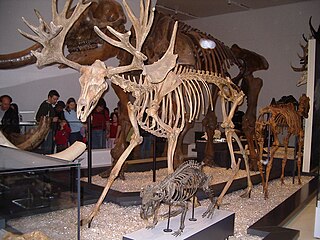 W
WCadurcodon is an extinct genus of amynodont rhino that lived during the Late Eocene to the Oligocene period. Fossils have been found throughout Mongolia and China. It may have sported a tapir-like proboscis due to the distinct features found in fossil skulls.
 W
WCervalces is an extinct deer genus that lived during the Pliocene and Pleistocene epochs. Cervalces gallicus, the ancestral species, lived in Europe from the Pliocene to the Pleistocene strata. Cervalces scotti, the stag-moose, lived in Pleistocene North America. Cervalces latifrons, the broad-fronted moose, and Cervalces carnutorum were found in Pleistocene Europe and Asia.
 W
WChilotherium is an extinct genus of rhinoceros endemic to Eurasia during the Miocene through Pliocene living for 13.7—3.4 mya, existing for approximately 10.3 million years .
 W
WDamalops is an extinct genus of Alcelaphinae. It lived during the Pleistocene in southern Asia, where the species Damalops palaeindicus is known from the Siwaliks in the northern part of the Indian Subcontinent.
 W
WDiceratherium is an extinct genus of rhinoceros endemic to North America, Europe, and Asia during the Oligocene through Miocene living from 33.9—11.6 mya, existing for approximately 22.3 million years . Mass estimates for the type species, D. armatum average around 1 t (2,200 lb)
 W
WDorcatherium is an extinct genus of tragulid ruminant which existed in Europe, East Africa and the Siwaliks during the Miocene and Pliocene.
 W
WDusisiren is an extinct genus of dugong related to the Steller's sea cow that lived in the North Pacific during the Neogene.
 W
WEucladoceros or bush-antlered deer is an extinct genus of deer whose fossils have been discovered in Europe, the Middle East and Central Asia. This genus was formally described by Hugh Falconer in 1868.
 W
WHipparion is an extinct genus of horse that lived in North America, Asia, Europe, and Africa during the Miocene through Pleistocene ~23 Mya—781,000 years ago. It lived in non-forested, grassy plains, shortgrass prairie or steppes.
 W
WHomotherium is an extinct genus of machairodontine saber-toothed cats, often termed scimitar-toothed cats, that inhabited North America, South America, Eurasia, and Africa during the Pliocene and Pleistocene epochs, existing for approximately 4 million years.
 W
WHyaenodon ("hyena-tooth") is the type genus of the Hyaenodontidae, a family of extinct carnivorous fossil mammals from Eurasia, North America, and Africa, with species existing temporally from the Eocene until the middle Miocene, existing for about 26.1 million years .
 W
WA mammoth is any species of the extinct elephantid genus Mammuthus, one of the many genera that make up the order of trunked mammals called proboscideans. The various species of mammoth were commonly equipped with long, curved tusks and, in northern species, a covering of long hair. They lived from the Pliocene epoch into the Holocene at about 4,000 years ago, and various species existed in Africa, Europe, Asia, and North America. They were members of the family Elephantidae, which also contains the two genera of modern elephants and their ancestors.
 W
WMegantereon was a genus of prehistoric machairodontine saber-toothed cat that lived in North America, Eurasia, and Africa. It may have been the ancestor of Smilodon.
 W
WPachycrocuta was a genus of prehistoric hyenas. The largest and most well-researched species is Pachycrocuta brevirostris, colloquially known as the giant short-faced hyena as it stood about 90–100 cm (35–39 in) at the shoulder and it is estimated to have averaged 110 kg (240 lb) in weight, approaching the size of a lioness, making it the largest known hyena. Pachycrocuta first appeared during the late Miocene and became extinct during the middle Pleistocene, 400,000 years ago.
 W
WPantolambda is an extinct genus of Paleocene pantodont mammal. Pantolambda lived during the middle Paleocene, and has been found both in Asia and North America.
 W
WParacamelus is an extinct genus of camel in the family Camelidae. It originated in North America during the Middle Miocene but crossed the Beringian land bridge into Eurasia during the Late Miocene, approximately 7.5–6.5 Ma; its later range spanned from Spain and Italy to Chad and Shanxi Province, China. It is ancestral to living camels of the genus Camelus. A population remained in northern North America, which became the high Arctic camel, which survived until the Middle Pleistocene approximately 1 Ma.
 W
WParamys is an extinct genus of rodents from North America, Europe, and Asia. It is one of the oldest genera of rodents known and probably lived in trees. While the genus name literally means "like a mouse", it coexisted with Thisbemys, a similar rodent, thus yielding a reference to Pyramus and Thisbe.
 W
WPhoberogale is an extinct genus of hemicyonine bear, which lived during the Early Miocene, found in France, California, and Pakistan, from 22 to 20 million years ago.
 W
WProboscidipparion is an extinct genus of horse that lived in Eurasia during the Pliocene around 7.1 - 4 million years ago. It is known for having a rather elongated skull, in which some speculate to have had a proboscis similar to a tapir. Fossils have been found throughout Eurasia, from England to China.
 W
WSinomastodon is an extinct gomphothere genus, from the Late Miocene to the Early Pleistocene deposits of Asia. It is not to be confused with the genus Mammut from a different proboscidean family, whose members are commonly called "mastodons".